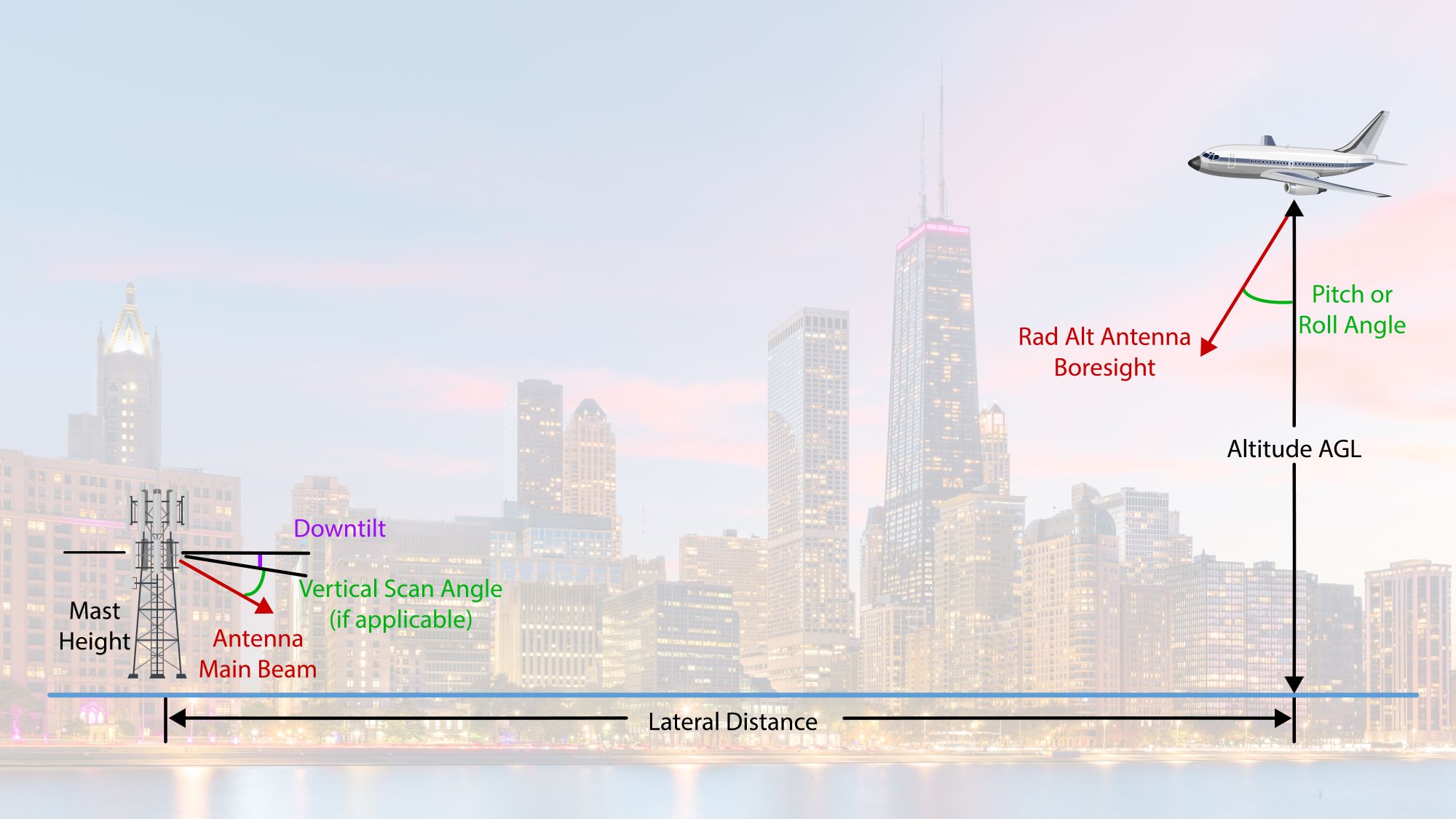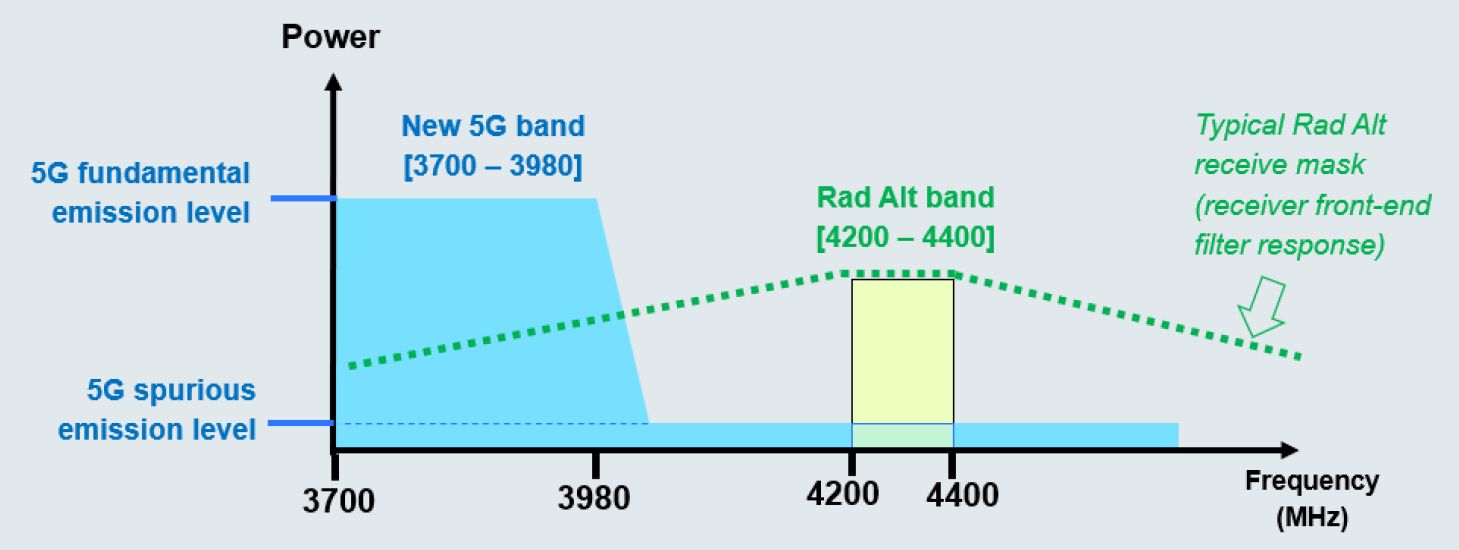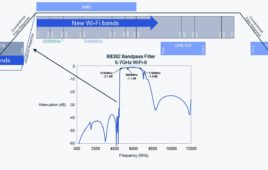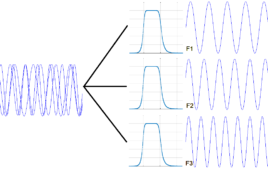The auctioning of the C-band for 5G use has raised concerns in North America that signals could interfere with aircraft altimeter operations. 5GTW asked a filter engineer and a test expert if there’s a problem and how to fix it.
When the FCC auctioned off spectrum in the C-band — 3.7 GHz to 3.98 GHz – winners including Verizon and AT&T spent over $81 billion to acquire portions of that spectrum. The use of the C-band for 5G raised concerns from the aviation industry regarding possible interference with aircraft altimeters.
The issue has caused delays in C-band implementation, now scheduled to begin on January 5, 2022 in the U.S. Furthermore, Canada has restricted the use of the C-band around 26 airports. In response, Verizon and AT&T have reluctantly agreed to reduce transmit power in the C-band, which the aviation industry calls “inadequate.” In another action, the FAA has restricted some flight operations in response to the issue.
While these actions may address the potential problem, they’re hardly a long-term solution, according to Mike Eddy VP, corporate business development & product marketing at Resonant, a manufacturer of RF filters. “Energy from 5G bands can enter the altimeter’s receiver,” said Eddy in an interview with 5G Technology World. “Any transmit system produces spurious noise, which can enter the band of a receiver.”
A 231 page report issued by aeronautics technical group RTCA in November 2020 explains the issue.
The fundamental emissions may lead to blocking interference in the radar altimeter receiver, wherein a strong signal outside of the normal receive bandwidth cannot be sufficiently filtered in the receiver to prevent front-end overload or other effects. The spurious emissions, on the other hand, fall within the normal receive bandwidth of the radar altimeter, and may produce undesirable effects such as desensitization due to reduced signal-to-interference-plus-noise ratio (SINR), or false altitude determination due to the erroneous detection of the interference signal as a radar return.
Figure 1, adapted from the report, provides a visual representation of how signals from a base station may occur at the same time and in proximity to altimeter signals.

Figure 1. Signals from 5G towers that use the C-band will likely occur at the same time as those transmitted from an aircraft altimeter, though at different frequencies. Image adapted from RTCA report “Assessment of C-Band Mobile Telecommunications Interference Impact on Low Range Radar Altimeter Operations, RTCA Paper No. 274-20/PMC-2073.”
“Altimeters have poor filters,” said Eddy. “Under that condition, spurious noise can enter band of receiver. That noise can come from both base stations and handsets. Eddy claims that poor filtering at the receivers raises the potential problem, though he noted that these interference problems are nonexistent in other parts of the world. As you might expect, the telcom industry, through CTIA, contends that claim saying “5G networks using a set of radio waves called ‘C-band spectrum’ operate safely and without causing harmful interference to aviation equipment.”

Figure 2. According to the RTCA report, altimeter receiver filters are inadequate to prevent C-band transmission energy from interfering with the altimeter’s receiver despite a 200-MHz guard band. Image: RTCA report “Assessment of C-Band Mobile Telecommunications Interference Impact on Low Range Radar Altimeter Operations, RTCA Paper No. 274-20/PMC-2073.”
Figure 2, from the report, shows the reason for concern in the aviation industry. Spurious emissions such as harmonics from 5G transmissions could leak into the altimeter’s receiver, potentially preventing it from receiving signals reflected from the ground. The lack of a sharp cutoff in an altimeter’s receiver filter — even with a 200 MHz guard band — is the primary source of concern.
Is my transmitter a good neighbor?” asks Roger Nichols, Keysight’s 5G/6G program manager. “Measurement of adjacent-channel leakage ratio (ACLR) and adjacent-channel power ratio (ACPR) tells if a transmitter (Tx) leaks into adjacent radio channels. There are related measurements called ‘spurious emissions,’ which are not necessarily in the adjacent radio channels, but they can cause interfere in adjacent channels in convoluted ways given a phenomenon called passive intermodulation distortion (PIM).”
Nichols continued by asking “Can my receiver handle a bad neighbor? Receiver measurements include adjacent channel rejection, the measurement of how well a radio receiver (Rx) blocks interfering energy from an unwanted transmit signal before the receiver can no longer provide adequate sensitivity.”
While these measurements are important, they take place in the lab and what we have here is a real-world problem. As the report points out, there can be more than one base station around an airport. That makes emulating the real world difficult.
Then here’s possible interference from handsets in the aircraft. “Handsets in the plane could be a problem,” said Eddy. “They transmit at lower power than base stations but are closer to the altimeter.” We all know that people often don’t follow the rules by turning off their phones setting them to airplane mode, nor turning off the 5G capability. Indeed, many people don’t even know how to invoke airplane mode, never mind turn off 5G. Phones without 5G won’t interfere with altimeters at all, but people are replacing their LTE phones with 5G every day.
“Some would argue,” said Nichols, “that radar altimeters use signals that travel in vertical directions and there is a significant guard-band (200 MHz) between commercial C-band and the radar-altimeter band. Large C-band deployments are already in place in Japan, Korea, China, Europe, and the co-existence (or adjacent existence) appears to be a non-issue. With radar altimeters in commercial aircraft flying over heavily populated urban areas when close to relatively dense mobile networks, higher Tx energy levels represent higher stakes in terms of safety and security. That’s why understanding this issue is critical.”
Nichols continued, saying “The long-term solution, should it be needed, is to retrofit or replace altimeters and use receiver filters with sharper cutoffs. That could significantly reduce unwanted energy from reaching the receiver. That costs money, takes time, and places the burden on aircraft manufacturers and aircraft operators which will certainly catch the eyes of the aviation industry.”
As the news reports indicate, Verizon and AT&T lowering their base-station transmit power and Canada’s limiting C-band transmissions are at best short-term solutions. Let’s face it, there’s too much money at stake. The telecom industry will continue to push for using the prime spectrum that the C-band provides.
“There’s a potential problem, added Eddy. “Politics and players: CTIA and FCC look after the telecom industry while FAA looks after the aircraft industry. The reports are all over the place.”





Interesting article and goes some way to investigate the problem. The Aviation industry should not have to bear any costs associated with modifying existing equipment. The equipment meets the current regulatory requirements domestic and internationally and the allocation of bandwidth expansion is purely dominated by financial considerations by sale and expansion, manufacture of user PEDs. If the industries associated with this financial gain would like to fund the required modifications, fine, however I suspect this probability veers towards the improbable.
Watch this space.
just put some 4150 4450 Mhz band pass on altimeter receiver and antenna path , and a big notch filter betwen 5g TX and its radiator
Build new altimeter devices for airlines. Then maybe airlines can utilize the 5g benift.
Robert Ladley has a point: Should airlines be forced to pay for altimeters with better filtering now that 5G has come along?
Fierce Wireless calls this an “aging altimeter problem.”
“Not our fault, blame the airlines” say the telecom carriers and press.
This is an ongoing story. The telecom news outlets are ablaze today with AT&T and Verizon’s letter to Secretary of Transportation Pete Buttigieg claiming that 5G won’t interfere with altimeters. The letter follow this one dated December 31 where Buttigieg and FAA Administrator Steve Dickson said:
Failure to reach a solution by January 5 will force the U.S. aviation sector to take steps to protect the safety of the traveling public, particularly during periods of low visibility or inclement weather. These steps will result in widespread and unacceptable disruption as airplanes divert to other cities or flights are canceled, causing ripple effects throughout the U.S. air transportation system.
The two telecom carriers base their conclusion on data citing no such incidents with altimeters and 5G in France. Is that good enough or is it just a matter of time?
The two companies have agreed to delay launch of C-band operations until January 19, pushing the launch date back by two weeks.
Right now, the talk is about interference from cellular base stations, but what about passengers who disobey crew instructions and keep right on using their phones during landings?
I’m a retired RF electronics engineer. This type of challenge, co-channel interference is well understood, and appears in many applications. The challenge/problem was then foreseeable to anyone expert in the art. In the past, the mission of the FCC was to manage compatibility issues among the many services using the RF spectrum. Why has this controversy arisen at such a late stage?
The FCC has decided to cede management of compatibility to the “free market”. If a compatibility issue arises, then the telecom companies and airlines will resolve their dispute through the courts. Meanwhile the FCC has gotten away with the $81 billion. In part this is a result of long standing budget cuts at the FCC. There is a role for government regulation to avoid the burdens of relying on legal processes.
However… that’s a terrible front end for aviation nav, and it stinks of leaving off a better one to cut down cost. Cheap can be very expensive.
The $81 billion generated from the spectrum auction went to the US Treasury, not to the FCC.
Most radar altimeters using FMCW were FAA approved using 1980 MOPS. A new MOPS for the altimeters must be implemented with better RF susceptibility level. The FAA knew 5G is coming but they ignored the issues. The FAA could ask Congress to set aside the money generated from the FCC’s auction to study the new MOPS or to retrofit the older altimeters.
So, your view of an alleged co-channel interference issue, where an astounding, unprecedented, unnecessary and spectrum-wasteful 400 MHz guard band exists between two non-competing radio spectrum services, is that our domestic government bureaucracy isn’t large enough and there exists too little regulation? Obviously your position is from a political and not RF engineering one.
If this discussion really does turn political, comments will be held back from publication or be subjected to editing. We haven’t reached that point yet, but we’re watching.
Just a reminder, let’s keep this discussion technical and not let it deteriorate into anything even slightly political. There are plenty of other sites for political discussions.
Case in point, “Wireless network operators and aviation authorities routinely trade barbs over spectrum, but this latest snafu takes things to a whole new level. The Federal Communications Commission (FCC), Federal Aviation Administration (FAA), and Department of Transportation have fantastically failed the people they are charged to serve,” wrote Matt Kepko on sdxCentral.
https://www.sdxcentral.com/articles/opinion-editorial/op-ed-mid-band-5g-meets-american-incompetence/2022/01/
Here are a few links if you’d like to follow the news of this mess.
https://www.rcrwireless.com/20220104/5g/verizon-att-change-course-agree-to-another-c-band-delay
https://www.sdxcentral.com/articles/news/verizon-att-pause-mid-band-5g-again/2022/01/
https://telecoms.com/512781/verizon-and-att-forced-to-delay-5g-expansion-once-more/
https://www.fiercewireless.com/wireless/airlines-file-emergency-petition-stop-5g-c-band-deployment-near-airports
Mobile World Live reports on January 18:
US aviation industry makes last-ditch C-Band 5G plea
The US aviation industry painted a picture of chaos and warned of a catastrophic crisis if 5G services are deployed in C-Band spectrum, as it reportedly again moved to block launches which have already been twice delayed.
Reuters reported chief executives of American Airlines, Delta Air Lines, United Airlines, Southwest Airlines and others had demanded swift action to avoid widespread disruption to services.
https://www.mobileworldlive.com/featured-content/home-banner/us-aviation-industry-makes-last-ditch-c-band-5g-plea
Light Reading reports on January 19:
“After another round of warnings from the airline industry, AT&T and Verizon on Tuesday said they would not turn on their 5G networks in C-band spectrum at an unspecified number of towers near airports.”
https://www.lightreading.com/5g/after-airlines-again-warn-of-chaos-atandt-verizon-tweak-5g-launch-plans/d/d-id/774664
RCR Wireless reports on January 19:
“AT&T and Verizon both confirmed this morning that they have gone ahead with their planned activation of the use of C-Band spectrum, amid dire warnings from the an aviation industry group earlier this week and last-minute concessions on the carriers’ part that will further constrain C-Band operations near airports.”
https://www.rcrwireless.com/20220119/5g/att-verizon-go-ahead-with-c-band-spectrum-light-up
Let the games begin.
January 20: Yesterday, AT&T and Verizon lit up their C-band transmitters. Mobile World Live reports “US airline industry predictions of chaos did not materialise as AT&T and Verizon launched commercial 5G services using C-Band spectrum, though several international flights were reportedly cancelled due to concerns over interference with aircraft altimeters.”
https://www.mobileworldlive.com/featured-content/top-three/global-airlines-shuffle-flights-as-us-c-band-takes-off
On February 4, Mobile World Live reported
US aviation industry airs C-Band concerns
https://www.mobileworldlive.com/featured-content/top-three/us-aviation-industry-airs-c-band-concerns
Figure 2 seems to show that altimeters have been allocated 200 MHz of spectrum (which already seems a lot, considering the amount of information involved) but are using quite a lot more, and up until now have been getting away with it.
The mobile industry seems to be in the position of someone who has been sold a building plot and the finds that someone from two doors down the road is using the space because, hey, it was empty so they just spread across it.
Figure 2 lacks a scale for the Y axis, but, from the look of it (-3dB/octave?), radar altimeters have practically no selectivity at all. I honestly doubt that any such lousy instrument would be designed. Especially because there may be very powerful C band radars in airports which would pose the same intermodulation and interference issues, if not worse, since radar antennas point upward, as 5G. Something doesn’t sound right in all this brouhaha.
I think it’s a case of that the altimeter filters were good enough when implemented, but perhaps not anymore.
FAA list of airports with a 5G buffer.
https://www.faa.gov/sites/faa.gov/files/2022-01/50%20Airports%20with%205G%20Buffer.pdf
In first term, we have to stay in clear that altimeter and radio altimeter, (RA) are different concepts.
While altimeter refers to the measurement with respect an altitude above the medium level sea, radio altimeter measurment is the height from the terrain to the aircraft between zero to 2,500 feet. This signal is the only clearance reference between the aircraft and the terrain below the plane.
The probable cause of interference in the use of C band in 5G technologies is related to aircrafts’ radio altimeters on board. This transceiver equipment transmit a rf signal between 4.2 to 4.4 GHz. While 5G technologies are uthorized to use the bandwidth between 3.7 GHz and 3.98 GHz.
In other hand, radio altimeter system on aircraft board is associated with other important systems, which gives to the fly crew information during takeoff, approach and landing phases.
There are three categories in radio altimeter systems related with Automatic Flight System, AFS; and Flight Guidance System, FGS.
Category 1, radio altimeter system supply infromation approach and high decision readouts to the crew.
Category 2 and category 3 radio altimeter supply height over terrain data to systems AFS and FGS capable to develop an auto land task.
Futhermore, radio altimeter signal is provided to other system called Ground Proximity Warning System, GPWS to advice the crew the terrain clearance or its proximity in the range between zero and 2500 feet.
If we review a simple signal analysis, appeal to Nyquist theorem we can able to understand that the channel capability of a 5G signal can be able to interfere with radio altimeter signal, in spurious harmonics if the transmitter power is greater.
We have to understand that there is a possiblity of a harmful interference in the use of 5G technologies, close to the range of 4.2 to 4.4 GHz, in particuoar for avionics systems.
Arturo Garcia Orozco
Telecommunication and Electronic Eng.
Engineering and Planning Mngr
TAR Airlines
The frequency range used by 5G until 2024 in the US is actually 3.7-3.8 GHz. And, as a telecom engineer, you well know that a device authorized to operate at any frequency range, 4.0-4.2 GHz in this case, has to be able to operate with emissions in other neighboring frequencies.
Ahem, 4.2 -4.4 GHz.
It could be a solution……
https://www.israeldefense.co.il/en/node/53315
@Moshe,
Maybe, but what’s described here is essentially having a “moderator” to give priority to one spectrum user over another. That’s similar to CBRS in U.S. Indeed, we posted an article about CBRS and spectrum sharing just today.
https://www.5gtechnologyworld.com/the-cbrs-band-depends-on-spectrum-management/
@Martin
Your response may be almost correct. The solution is also “moderator” In some cases, in cases where there is 100% damage or damage to one of the sides that does not allow proper work on the spectrum then in such a case a full simulation is required.
Do you know if a full simulation has been done?
I agree that the FCC has lost its marbles. They used to be responsible for presiding over the carefully distributed RF spectrum, but in recent decades, they have been blinded by the financial and political greed. Typically, the culprit (terrestrial telecom transmitters) bears the responsibility for correcting the problem and, if necessary, and paying damages to the victim (incumbent aviation industry). The telecom companies are well aware of the spectral mask requirements that are designed to minimize adjacent channel interference. It’s not magic, or late breaking news. The telecom industry, with help from the FCC, just ignored it.
That’s not the message I get from Figure 2.
Figure 2 is just showing a “typical” receiver front-end filter response and that’s not regulated. Transmitters are regulated, but poorly enforced and that’s what happened here. There are National and International spectral mask requirements on transmitters to limit adjacent channel interference. An example can be seen in the NTIA Annex J where (for some applications) transmitters require no attenuation within the modulation bandwidth (necessary bandwidth), but out of band rolls off at -40 dBsd to -60dBsd within the allocated channel.
Per the 3GPP technical specifications, 5G transmitters are attenuated at -13dBm per 0.2 MHz outside their band. Given that until 2024 the guard band between 5G and radio altimeters is 400 MHz, the possibility of interference is nil, even with such a lousy front end receiver at in Fig. 2.
Remember, the altimeter works like a radar. The altimeter transmitter has to comply with spectral mask requirements as well and the altimeter receiver bandwidth has to be wide enough to receive weak reflections. So, it’s necessary for the receiver bandwidth to be very wide. It’s not a “lousy front end receiver”, it’s a necessary front end receiver. You can’t expect the airline industry to spend a fortune to retrofit proven safety equipment because the FCC and Telecom industry bent the rules to make money.
Stories in the UK press this week that it’s only Boeing planes that are affected, and indeed only certain models. Not including the 737max, which no doubt has had a thorough review as part of the recertification after the MCAS issues.
I would like to know what the signal strength or output power is on 5g altimeters. %g is known to need more closer spaced cell towers and repeaters because it doesn’t propigate long distances well….. well 5 miles high in an airplane would require a 5g 4.2 – 4.4 ghz signal that could propigate and return double the altitude. How much power has to be outputted by the transceiver to push a 5g wave as much as 10 miles without any repeaters?
Thank you